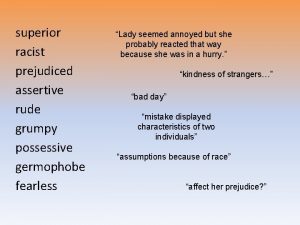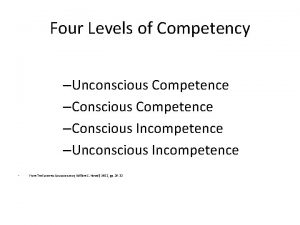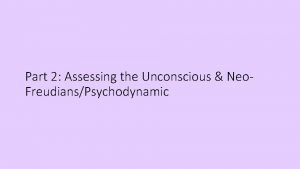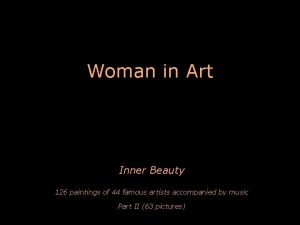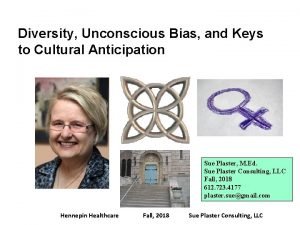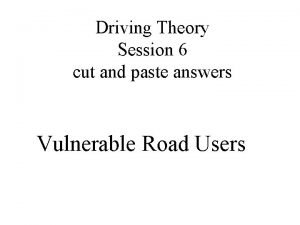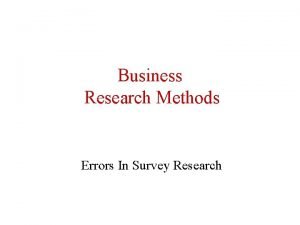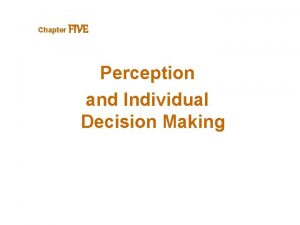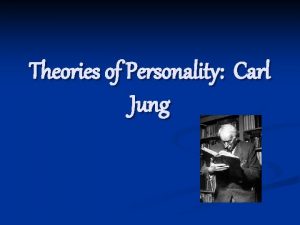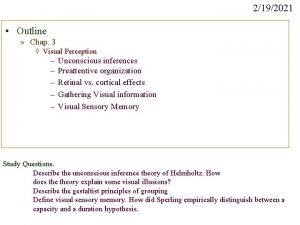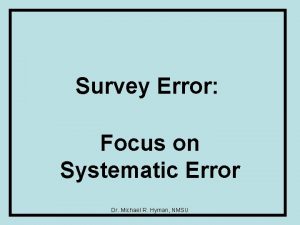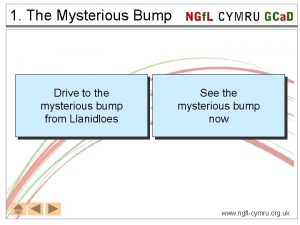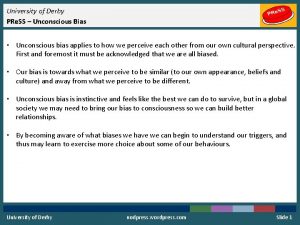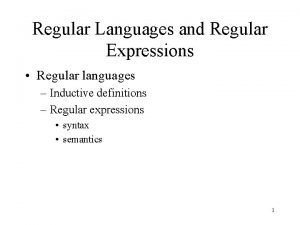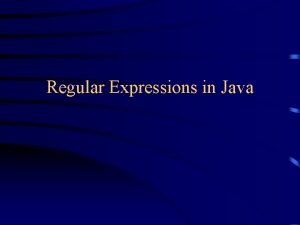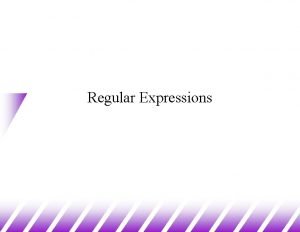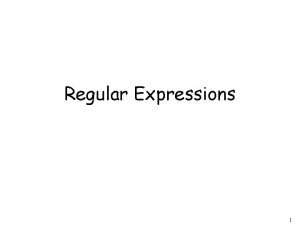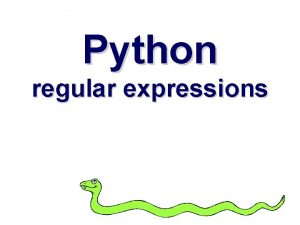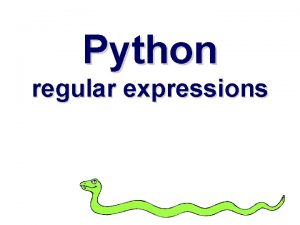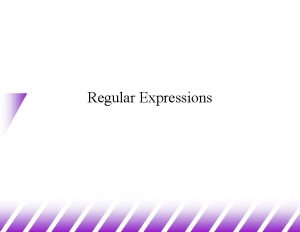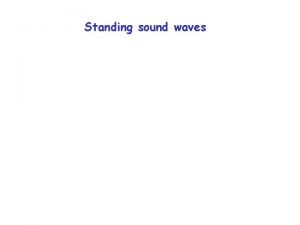Sound change the regular the unconscious the mysterious













![The English Great Vowel shift (Jespersen) /i: / [iy] [uw] /e: / /æ: / The English Great Vowel shift (Jespersen) /i: / [iy] [uw] /e: / /æ: /](https://slidetodoc.com/presentation_image/52dd89f51209a7b981ae2727e22dbd60/image-14.jpg)














![Distribution of /ow/ vowels for all of North America. [N=8313]. Vowels before /l/ are Distribution of /ow/ vowels for all of North America. [N=8313]. Vowels before /l/ are](https://slidetodoc.com/presentation_image/52dd89f51209a7b981ae2727e22dbd60/image-29.jpg)



![Regression coefficients for the fronting of /ow/ in ANAE data [N=7796] p <. 00001 Regression coefficients for the fronting of /ow/ in ANAE data [N=7796] p <. 00001](https://slidetodoc.com/presentation_image/52dd89f51209a7b981ae2727e22dbd60/image-33.jpg)













![Formant measurements of word lists read by advanced speakers in Birmingham [B], Chicago[C] and Formant measurements of word lists read by advanced speakers in Birmingham [B], Chicago[C] and](https://slidetodoc.com/presentation_image/52dd89f51209a7b981ae2727e22dbd60/image-47.jpg)





















![Natural misunderstanding: pets => pots Telephone surveyor [Chicago]: Do you have any pets in Natural misunderstanding: pets => pots Telephone surveyor [Chicago]: Do you have any pets in](https://slidetodoc.com/presentation_image/52dd89f51209a7b981ae2727e22dbd60/image-69.jpg)









- Slides: 78

Sound change: the regular, the unconscious, the mysterious W. Labov, U. of Pennsylvania Colloquy on Hermann Paul FRIAS/HPCL May 15, 2009

Power. Point available on www. ling. upenn. edu/~labov

PRINCIPLES OF THE Herman Paul HISTORY OF LANGUAGE BY HERMANN PAUL TRANSLATED FROM THE SECOND EDITION OF THE ORIGINAL BY H. A. STRONG, M. A. , LL. D. NEW YORK MACMILLAN & CO. 1889

Summary of the critique of Paul in WLH 1968 • the sole theoretically grounded object of linguistic study is the idiolect, but there is no explanation as to how community consensus is achieved. • change may come about when an individual skews the distribution of his performance to seek more comfortable behavior patterns, but this key term is not defined, nor is their any accounting of the sporadic character of this adjustment. • the grouping of idiolects with respect to features shows no organization that would prefer one grouping rather than another.

Summary of the appreciation of Paul in WLH 1968 Paul’s Principien may be said to reflect the best achievements of Neogrammarian linguistics. • maximum rigor of formulation of the regularity principle • an intensive interest in recurrent regularities • a concern with phonetic detail • a feeling for the atypicality of standardized languages among the totality of languages • a desire to “portray as many-sidedly as possible the conditions of the life of language [Sprachleben]”. • recognition of the dialectological point of view on language change.

regularity

The Neogrammarian position Every sound change, inasmuch as it occurs mechanically, takes place according to laws that admit no exception. Brugmann 1878 --Ostoff and

Paul on uniformity We have now to answer the important question, which has been in recent times the subject of so much dispute: Can we assert uniformity of soundlaws? . . Sound-law does not pretend to state what must always under certain general conditions regularly recur, but merely express the reign of uniformity within a group of definite historical phenomena. PHL 56 -57.

Paul on the regularity of sound change It must either happen, therefore, that where the same sound existed previously, the same sound always remains in the later stages of development as well; or, where a separation into different sounds has occurred, there must be a special reason to be assigned; and further, a reason of a kind affecting sound alone PHL p. 58

Twentieth century formulation of the Neogrammarian position Sound-change is merely a change in the speakers’ manner of producing phonemes and accordingly, affects a phoneme at every occurrence, regardless of the nature of any particular linguistic form in which the phoneme happens to occur. . . The whole assumption can be briefly put into the words: phonemes change. --Bloomfield 1933: 353 -4

Lexical diffusion � The phonetic law does not affect all items at the same time: some are designed to develop quickly, others remain behind, some offer strong resistance and succeed in turning back any effort at transformation. --Gauchat (cited in Dauzat 1922) We hold that words change their pronunciations by discrete, perceptual increments (i. e. , phonetically abrupt) but severally at a time (i. e. , lexically gradual) --Wang and Chen 1977: 150.

Exemplar theory and lexical diffusion The assumption that people learn phonetic categories by remembering many labeled tokens of these categories explains. . . why leniting historical changes are typically more advanced for high-frequency words than lowfrequency words. -- Pierre-Humbert: Exemplar dynamics: word frequency, lenition and contrast (2000). To appear in J. Bybee and P. Hopper (eds. ), Frequency effects and emergent grammar.

Resolving the Neogrammarian Controversy (Labov 1981) Regular sound change is the result of a gradual transformation of a single phonetic feature of a phoneme in a continuous phonetic space. Lexical diffusion is the result of the abrupt substitution of one phoneme for another in words that contain that phoneme.
![The English Great Vowel shift Jespersen i iy uw e æ The English Great Vowel shift (Jespersen) /i: / [iy] [uw] /e: / /æ: /](https://slidetodoc.com/presentation_image/52dd89f51209a7b981ae2727e22dbd60/image-14.jpg)
The English Great Vowel shift (Jespersen) /i: / [iy] [uw] /e: / /æ: / /u: / /o: / [ay] [aw] /ɔ: /

Ogura on lexical diffusion in the English Great Vowel Shift “The data in Appendix B clearly show that the change of ME i: does not simultaneously occur but gradually extends its scope across the lexicon) We have claimed that the processes of the development of ME i: and u: have propagated themselves gradually from morpheme to morpheme. ” --Mieko Ogura 1987. Historical English Phonology: A Lexical Perspective. Tokyo: Kenkyusha. p. 45)

Phonetic realizations of M. E. u: words in the Survey of English Dialects

Multi-dimensional scaling of all M. E. i: words

The i: 2 class (i: 2): M. E. short i followed by a velar consonant and /t/ in right, night, fight, sight, etc. In the history of the best known dialects, the velar was first realized as a voiceless palatal and then disappeared, with compensatory lengthening of the vowel.

The i: 3 class (i: 3): long e: followed by g in Old English in lie, fly, die, and long ɛ: in eye, etc. The /g/ has been lenited in all the dialects covered by the Orton Atlas, but the raising of the vowel to i: did not occur in all dialects.

Muli-dimensional scaling of core M. E. i: words

Reports of lexical diffusion, 1970 -1997 1970 Cheng, Chin-Chuan, and Wang, Wm. S-Y. 1970. Phonological change of Middle Chinese initials. University of California (Berkeley) Dept. of Linguistics. Project on Linguistic Analysis, Second Series, 10 CW 1 - CW 69. 1973 Sherman, D. 1973. Noun-verb stress alternation: an example of the lexical diffusion of sound change in English. Project on Linguistic Analysis, Reports, Second Series, 17: 46 -81. 1976 Barrack, C. M. 1976. Lexical diffusion and the High German consonant shift. Lingua 40: 151 -75. Toon, Thomas E. 1976. The variationist analysis of Early Old English manuscript data. In W. M. Christie Jr. (ed. ), Proceedings of the Second International Conference on Historical Linguistics. Amsterdam: North Holland. Pp. 71 -81. Toon, Thomas E. . 1976. The actuation and implementation of an Old English sound change. In R. J. Di Pietro & E. L. Blansitt (eds. ), The Third Lacus Forum. Pp. 614 -622. Columbia, SC: Hornbeam Press, Inc. 1977 Cheng, Chin-chuan and William S. -Y. Wang. 1977. Tone change in Chaozhou Chinese: a study of lexical diffusion. In W. S-Y. Wang (ed), The Lexicon in Phonological Change. The Hague: Mouton Pp. 86 -100. Wang, William S. -Y. and C. -C. Cheng. 1977. Implementation of phonological change: the Shaungfeng Chinese case. In W. S-Y. Wang (ed. ), The lexicon in phonological change. The Hague: Mouton.

Reports of lexical diffusion, 1977 -1982 1977 Janson, Tore. 1977. Reversed lexical diffusion and lexical split: Loss of -d in Stockholm. In Wang (ed. ), The Lexicon in Phonological Change. The Hague: Mouton. Pp. 252 -65. Lyovin, Anatole. 1977. Sound change, homophony, and lexical diffusion. In W. Wang (ed. ), The Lexicon in Phonological Change. The Hague: Mouton. Pp. 120 -32. 1978 Krishnamurti, Bh. 1978. Areal and lexical diffusion of sound change. Language 54. 1 -20. Toon, Tomas E. 1978. Lexical diffusion in Old English. CLS. Papers from the Parasessions on the Lexicon. 1979 Wang, William S. -Y. 1979. Language change--a lexical perspective. Ann. Rev. Anthropol. 8: 353 -71. 1980 Milroy, James. 1980. Lexical alternation and the history of English: evidence from an urban vernacular. In E. Traugott et al. (ed. , Papers from the 4 th International Conference on Historical Linguistics. Amsterdam: John Benjamins. Phillips, B. S. 1980. Lexical diffusion and Southern Tune, Duke, News. American Speech 56: 72 -78. 1981 Wallace, Rex. 1981. The variable deletion of final s in Latin. Ohio State M. A. Thesis. Bauer, Robert S. 1982. Cantonese sociolinguistic patterns: correlating social characteristics of speakers with phonological variables in Hong Kong Cantonese. U. of California Berkeley dissertation.

Reports of lexical diffusion, 1982 -1987 1982 Li, Paul Jen-Kuei. 1982. Linguistic variations of different age groups in the Atayalic dialects. The Tsing Hua Journal of Chinese Studies, new series, 14: 167 -191. Chan, Marjorie K. M. 1983. Lexical diffusion and two Chinese case studies re-analyzed. Acta Orientalia 44: 117 -52. 1983 Phillips, Betty S. 1983. Middle English diphthongization, phonetic analogy, and lexical diffusion. WORD 34. 1: 11 -23. April 1983. 1984 Phillips, B. S. 1984. Word frequency and the actuation of sound change. Language 60: 32042. Wallace, Rex. 1984. Variable deletion of -s in Latin: Its consequences for Romance. In Baldi, P. (ed), Papers from the XIIth Linguistic Symposium on Romance Languages. Philadelphia: J. , Benjamins. Pp. 565 -577. 1985 Fagan, D. S. 1985. Competing sound change via lexical diffusion in a Portuguese dialect. Sezione Romanza 27: 263 -92. , . 1986 Bauer, Robert S. 1986. The microhistory of a sound change in progress in Hong Kong Cantonese. Journal of Chinese Linguistics 14: 1 -41. 1987 Lien, Chinfa. 1987. Coexistent tone systems in Chinese dialects. Berkeley: University of California dissertation.

Reports of lexical diffusion, 1987 -1991 1987 Gamble, G. 1987. Nootkan glottalized resonsants in Nitinat: a case of lexical diffusion. In W. Wang (ed. ), The Lexicon in Phonological Change. The Hague: Mouton. Pp. 266 -278. Ogura, Mieko. 1987. Historical English Phonology: A Lexical Perspective. Tokyo: Kenkyusha. 1989 Harris, John. 1989. Towards a lexical analysis of sound change in progress. Journal of Linguistics 25: 35 -56. Labov, William. 1989. The exact description of the speech community: short a in Philadelphia. In R. Fasold & D. Schiffrin (eds. ), Language Change and Variation. Washington, Georgetown U. P. Pp. 1 -57. Phillips, Betty S. 1989. The Diffusion of a Borrowed Sound Change. JENGL 22. 2, October 1990 Shen, Zhongwei. 1990. Lexical diffusion: a population perspective and a numerical model. Journal of Chinese Linguistics 18: 159 -200. 1991 Ogura, Mieko, William S. -Y. Wang and L. L. Cavalli-Sforza. 1991. The development of ME i in England: a study in dynamic dialectology. In P. Eckert (ed. ), New Ways of Analyzing Sound Change. New York: Academic Press, pp. 63 -106. .

Reports of lexical diffusion, 1993 -2006 1993 Wang, William S. -Y. and Chinfa Lien 1993. Bidirectional diffusion in sound change. In Charles Jones (ed. ), Historical Linguistics: Problems and Perspectives. London: Longman Ltd. Pp. 345 -400. 1997 Krishnamurti, Bh. 1997. Regularity of sound change through lexical diffusion (A study of s > h > zero in Gondi dialects. Paper presented to the Panel on Lexical Diffusion at the 16 th Intwernational Congress of Linguists, Paris, July 21. 1998 Krishnamurti, Bh. 1998. Regularity of sound change through lexical diffusion: A study of s > h > 0 in Gondi dialects. Language Variation and Change 10: 193 -220. 2006 Phillips, Betty S. 2006. Word frequency and lexical diffusion. New York: Palgrave Macmillan. .

ANAE Atlas of North American EQnglish

Principles of Linguistic ANAE Change, Vol. III Chapter 13 Words floating on the surface of sound change

Fronting of /ow/ in North America
![Distribution of ow vowels for all of North America N8313 Vowels before l are Distribution of /ow/ vowels for all of North America. [N=8313]. Vowels before /l/ are](https://slidetodoc.com/presentation_image/52dd89f51209a7b981ae2727e22dbd60/image-29.jpg)
Distribution of /ow/ vowels for all of North America. [N=8313]. Vowels before /l/ are shown in black [N=1577].

Absence of fronting of Vw in vowel system of Alex S. , 42, Providence, RI TS 474.

Fronting of all Vw in the vowel system of Danica L. , 37, Columbus, OH, TS 737.

34 most frequent /ow/ words in the Brown and Telsur corpora
![Regression coefficients for the fronting of ow in ANAE data N7796 p 00001 Regression coefficients for the fronting of /ow/ in ANAE data [N=7796] p <. 00001](https://slidetodoc.com/presentation_image/52dd89f51209a7b981ae2727e22dbd60/image-33.jpg)
Regression coefficients for the fronting of /ow/ in ANAE data [N=7796] p <. 00001 <. 05

Surviving regression coefficients in both halves of a random split in the /ow/ tokens [even = 3927, odd = 3869]F 1/F 2 position of 348 no tokens in /ow/ distribution [N=8296] no home p <. 00001 <. 05

Fronting of /ow/ for words before /l/ and others for all of North America and for the Southeast (South and Midland). Words selected by regression analysis at p <. 001 level as ahead of phonological prediction, light blue; behind, yellow.

�Paul on the fluctuation of words Vacillations of pronunciation caused by quicker or slower, louder or gentler, more careful or more negligent utterances, will always affect the same element in the same manner, no matter in what word it may occur -PHL 59 -

Absence of fronting of Vw in vowel system of Alex S. , 42, Providence, RI TS 474.

Fronting of all Vw in the vowel system of Danica L. , 37, Columbus, OH, TS 737.

Is home a lexical exception to the fronting of /ow/? N F 1 F 2 /ow/ 5950 616 1304 /owl/ 2576 575 1010 home 775 669 1068 Oklahoma 14 589 1045 homebody, etc. 28 641 1037 Omaha 10 655 1119 hoe 26 621 1233

The /h_m/ effect on the fronting of /ow/

the unconscious

Paul on the unconscious character of sound change. . . there is no such thing as a conscious effort to prevent sound change. For those who are affected by the chnge have no suspicion that there is anything to guard against, and they pass their lives always in the simple belief that they speak today as they spoke years ago, and that they will continue to the end to speak in the same way. PHL 48.

Conscious correction of a completed change: reading and word lists in New York City We chased him with a ba--a baseball bat and yell, “Bad boy! bad, bad! but he was too. . fast, only my aunt could catch him. Paul all ball awful coffee office chalk chocolate chock

Project on Cross-Dialectal Comprehension: Gating Experiment 2 Word Phrase Sentence 1. ________________ 2. ________________ 3. ________________ 4. ________________ 5. ________________ 6. ________________

The Northern Cities Shift desk mat busses head block socks boss

Percent correct in Gating Experiments by city and educational level in Cross Dialectal Comprehension study: block living on Senior citizens one block living on one block
![Formant measurements of word lists read by advanced speakers in Birmingham B ChicagoC and Formant measurements of word lists read by advanced speakers in Birmingham [B], Chicago[C] and](https://slidetodoc.com/presentation_image/52dd89f51209a7b981ae2727e22dbd60/image-47.jpg)
Formant measurements of word lists read by advanced speakers in Birmingham [B], Chicago[C] and Philadelphia [P]

Adult change in real time? Were anyone able to compare the movements which his organs made in the utterance of a word many years before with those which he makes at present, he would most likely find a striking difference. But to make any such real comparison would be an impossibility. PHL 48

Real time changes in the lenition of (ch) in Panama City in Cedergren’s trend study, 1969 -1982

Model of generational change of (ch) in Panama City with no age-grading

Regression analyses of fronting of (aw) of men and women by decade in the Philadelphia Neighborhood Study [N=112]

Lifespan trajectory of a hypothetical sound change for females born in 1962, 1970, 1986 with no adult increment (Labov 1994) b. 1986 b. 1970 b. 1962

The critical period revised: possible models of adult participation in sound change Stable Linear Inverse power

Lifespan trajectory of a hypothetical sound change for females born in 1962, 1970, 1986 with progressively diminishing adult incrementation: cut-off point 17 years b. 1986 b. 1970 r 2=. 998 b. 1962

mysteries

The individual and the community all purely psychical reciprocal operation comes to its fulfillment in the individual mind alone. PHL xxxvii All that we imagine that we know about the ideas of another individual depends exclusively upon conclusions drawn from our own. PHL xxxix The great resemblance of all linguistic processes n the most different individuals is the most essential foundation for an exact scientific knkowledge of these processes. PHL xlv

The enigma of uniformity It is by intercourse, and nothing else, that the language of the individual is generated. PHL 23 If we start with the undeniable truth that each individual has his or her own language, and that each such language has its own history, the problem is not so much how from a language essentially uniform different dialects arise. . The problem which challenges solution is this: How comes it that while the language of each individual has its own special history, this degree of agreement--a certain greater or less--maintains itself within this miscellaneously constituted group of individuals? PHL 23

Auer and Hinskens (2005): The role of interpersonal accommodation in a theory of language change accommodation by the socially integrated speakers of type A. . . is often surpassed by type D speakers. . . with loose and ephemeral network contacts who are highly dissatisfied with their social life. . . It appears that the best predictor of accommodation is not frequency of interaction but instead a strong attitudinal orientation towards the group with whom one wants to associate -- p. 356

Auer and Hinskens (2005) conclusion . . . we certainly cannot exclude the possibility that participants in the interaction accommodate to each other’s behavior nor can we exclude the possibility that the frequency of exposure to a new, spreading feature through intensive network contacts with its users can lead to the adoption of this variable.

The fronting of (aw) shown by increase of the second formant with diminishing age in the Philadelphia Neighborhood Study [N=112]

Figure 5. The curvilinear pattern for social class in the fronting of (aw) in south, down, out, etc. in Philadelphia Celeste 2578 Hz

The communication index C 5 Combines answers to questions about the density of communication on the block: How many people on the block do you say hello to? have coffee with? ask for advice? . . . with the proportion of friends who live off the block.

Scattergram of the fronting of (aw) by the communication index C 5 for women in four Philadelphia neighborhoods

Sociometric position of Celeste S. in the Clark St. network (Upper figure: advancement of change, lower figure, C 5 index).

The two-step flow of communication (Katz and Lazarsfeld, Personal Influence)

Fronting of /ey/ (F 2) for in closed syllables in made, pain, lake, etc. by age with partial Fronting of (aw) 112 speakers the Philadelphia Neighborhood Study regression linesclass for 6 socioeconomic groups in Philadelphia [N=112] by age and social

On the negative effects of sound change Thus the symmetry of any system of forms meets in sound change an incessant and aggressive foe. It is hard to realize how disconnected, confused, and unintelligible language would gradually become if it had patiently to endure all the devastations of sound change. Paul 1891

Natural misunderstanding: cat => cod Neither my boyfriend Dave nor I are natives to Michigan, and we are not NCS speakers. Dave had the following misunderstanding happen three times in the Lansing area, at two different grocery stores, with two different workers: he asked for 'catfish' and the man behind the counter gave him cod, thinking he said 'codfish. ’
![Natural misunderstanding pets pots Telephone surveyor Chicago Do you have any pets in Natural misunderstanding: pets => pots Telephone surveyor [Chicago]: Do you have any pets in](https://slidetodoc.com/presentation_image/52dd89f51209a7b981ae2727e22dbd60/image-69.jpg)
Natural misunderstanding: pets => pots Telephone surveyor [Chicago]: Do you have any pets in the house? Brian T. [Eastern US] => pots. [thought that 'pot' was not likely since everyone has pots and pot = marijuana was too personal; asked for repetition several times until understood. ]

Map 11. 8. North American dialects

The U. S. at Night

The Inland North U. S. at Night Milwaukee Grand Rapids Chicago Syracuse Rochester Flint Buffalo Detroit Cleveland Kenoshat Joliet Toledo

Settlement patterns 1800 -1850 (Kniffen and Glassie 1966)

Figure 3. 2. Relationships among America’s Most Populous Metropolitan Areas

Caption for Figure 3. 2. Relationships among America’s Most Populous Metropolitan Areas. Heavy lines indicate the largest outflows of interstate telephone calls for a sample period in 1968. Light lines indicate largest or second largest outflows of air passengers from SMSAs over 250, 000. The flows mapped from open city symbols are primary flows; flows mapped from solid city symbols are second largest outflows or traffic shadow assignments if they are within about 100 miles of their superordinate. With the exception of places very close to one of the 20 study regions, almost all of the places east of the Mississippi for which secondary flows are indicated sent their primary outflow to New York City. Sources: Telephone call data: American Telephone and Telegraph Company. Air Passenger Data: courtesy of Professor Michael O. Filani, University of Ibadan.

Figure 9. The UD measure of the Northern Cities Shift

Summary of the appreciation of Paul in WLH 1968 Paul’s Principien may be said to reflect the best achievements of Neogrammarian linguistics. • maximum rigor of formulation of the regularity principle • an intensive interest in recurrent regularities • a concern with phonetic detail • a feeling for the atypicality of standardized languages among the totality of languages • a desire to “portray as many-sidedly as possible the conditions of the life of language [Sprachleben]”. • recognition of the dialectological point of view on language change.

Summary of the critique of Paul in WLH 1968 • the sole theoretically grounded object of linguistic study is the idiolect, but there is no explanation as to how community consensus is achieved. √ the answer must lie in transmission among children, but there is some evidence for an ideological substratum among adults • change may come about when an individual skews the distribution of his performance to seek more comfortable behavior patterns, but this key term is not defined, nor is their any accounting of the sporadic character of this adjustment. √ principle of maximal dispersion combined with general principles governing chain shifting • the grouping of idiolects with respect to features shows no organization that would prefer one grouping rather than √ some progress on the actuation problem in searching for triggering events in both linguistic and social context √ ANAE defines dialects by the active chain shifts in progress, in a phonology organized as hierarchical sets of subsystems in the framework of Martinet and Weinreich
 Regular grammar generates regular language
Regular grammar generates regular language The mysterious box short story
The mysterious box short story The mysterious fall of the nacirema
The mysterious fall of the nacirema Mysterious ziggy
Mysterious ziggy Regular pattern of sound
Regular pattern of sound Unconscious patronization
Unconscious patronization Unconscious competence
Unconscious competence Freud fixation theory
Freud fixation theory Alfred adler collective unconscious
Alfred adler collective unconscious Unconscious
Unconscious Carl jung archetypes
Carl jung archetypes Topographical model of the mind
Topographical model of the mind Unconscious bias icebreaker
Unconscious bias icebreaker Unconscious facial expressions
Unconscious facial expressions You should never attempt to overtake a cyclist
You should never attempt to overtake a cyclist Unconscious bias questions
Unconscious bias questions Auspices bias
Auspices bias Unconscious vs conscious proprioception
Unconscious vs conscious proprioception Is an unconscious process created from distilled experience
Is an unconscious process created from distilled experience Amber nova unconscious
Amber nova unconscious Unconscious bias and language
Unconscious bias and language Carl.jung theory
Carl.jung theory Helmholtz unconscious inference
Helmholtz unconscious inference Meaning of unconscious mind
Meaning of unconscious mind Auspices bias
Auspices bias Unconscious proprioception
Unconscious proprioception Ehat is sound
Ehat is sound “a sound mind is in a sound body”
“a sound mind is in a sound body” Is chopping a tree a chemical change
Is chopping a tree a chemical change Chemical change and physical change
Chemical change and physical change Absolute change and relative change formula
Absolute change and relative change formula How does a physical change differ from a chemical change? *
How does a physical change differ from a chemical change? * Supply and demand curve shifts
Supply and demand curve shifts Spare change physical versus chemical change
Spare change physical versus chemical change Two negative integers
Two negative integers Painting a wall physical or chemical change
Painting a wall physical or chemical change Climate change 2014 mitigation of climate change
Climate change 2014 mitigation of climate change Cake chemical change
Cake chemical change Enagic comp plan
Enagic comp plan Rocks change due to temperature and pressure change
Rocks change due to temperature and pressure change Chemical change example
Chemical change example Difference in physical and chemical changes
Difference in physical and chemical changes First order vs second order change
First order vs second order change Reactive change is change that
Reactive change is change that Physical change and chemical change venn diagram
Physical change and chemical change venn diagram Input and output market
Input and output market Sơ đồ cơ thể người
Sơ đồ cơ thể người Số nguyên là gì
Số nguyên là gì đặc điểm cơ thể của người tối cổ
đặc điểm cơ thể của người tối cổ Mật thư tọa độ 5x5
Mật thư tọa độ 5x5 Các châu lục và đại dương trên thế giới
Các châu lục và đại dương trên thế giới Chụp tư thế worms-breton
Chụp tư thế worms-breton ưu thế lai là gì
ưu thế lai là gì Thẻ vin
Thẻ vin Tư thế ngồi viết
Tư thế ngồi viết Cái miệng xinh xinh thế chỉ nói điều hay thôi
Cái miệng xinh xinh thế chỉ nói điều hay thôi Các châu lục và đại dương trên thế giới
Các châu lục và đại dương trên thế giới Từ ngữ thể hiện lòng nhân hậu
Từ ngữ thể hiện lòng nhân hậu Bổ thể
Bổ thể Tư thế ngồi viết
Tư thế ngồi viết Thế nào là giọng cùng tên? *
Thế nào là giọng cùng tên? * Phép trừ bù
Phép trừ bù Thể thơ truyền thống
Thể thơ truyền thống Bài hát chúa yêu trần thế alleluia
Bài hát chúa yêu trần thế alleluia Khi nào hổ con có thể sống độc lập
Khi nào hổ con có thể sống độc lập đại từ thay thế
đại từ thay thế Diễn thế sinh thái là
Diễn thế sinh thái là Vẽ hình chiếu vuông góc của vật thể sau
Vẽ hình chiếu vuông góc của vật thể sau Công của trọng lực
Công của trọng lực Thế nào là mạng điện lắp đặt kiểu nổi
Thế nào là mạng điện lắp đặt kiểu nổi Tỉ lệ cơ thể trẻ em
Tỉ lệ cơ thể trẻ em Lời thề hippocrates
Lời thề hippocrates Vẽ hình chiếu đứng bằng cạnh của vật thể
Vẽ hình chiếu đứng bằng cạnh của vật thể Quá trình desamine hóa có thể tạo ra
Quá trình desamine hóa có thể tạo ra Môn thể thao bắt đầu bằng chữ đua
Môn thể thao bắt đầu bằng chữ đua Hình ảnh bộ gõ cơ thể búng tay
Hình ảnh bộ gõ cơ thể búng tay Sự nuôi và dạy con của hổ
Sự nuôi và dạy con của hổ điện thế nghỉ
điện thế nghỉ





